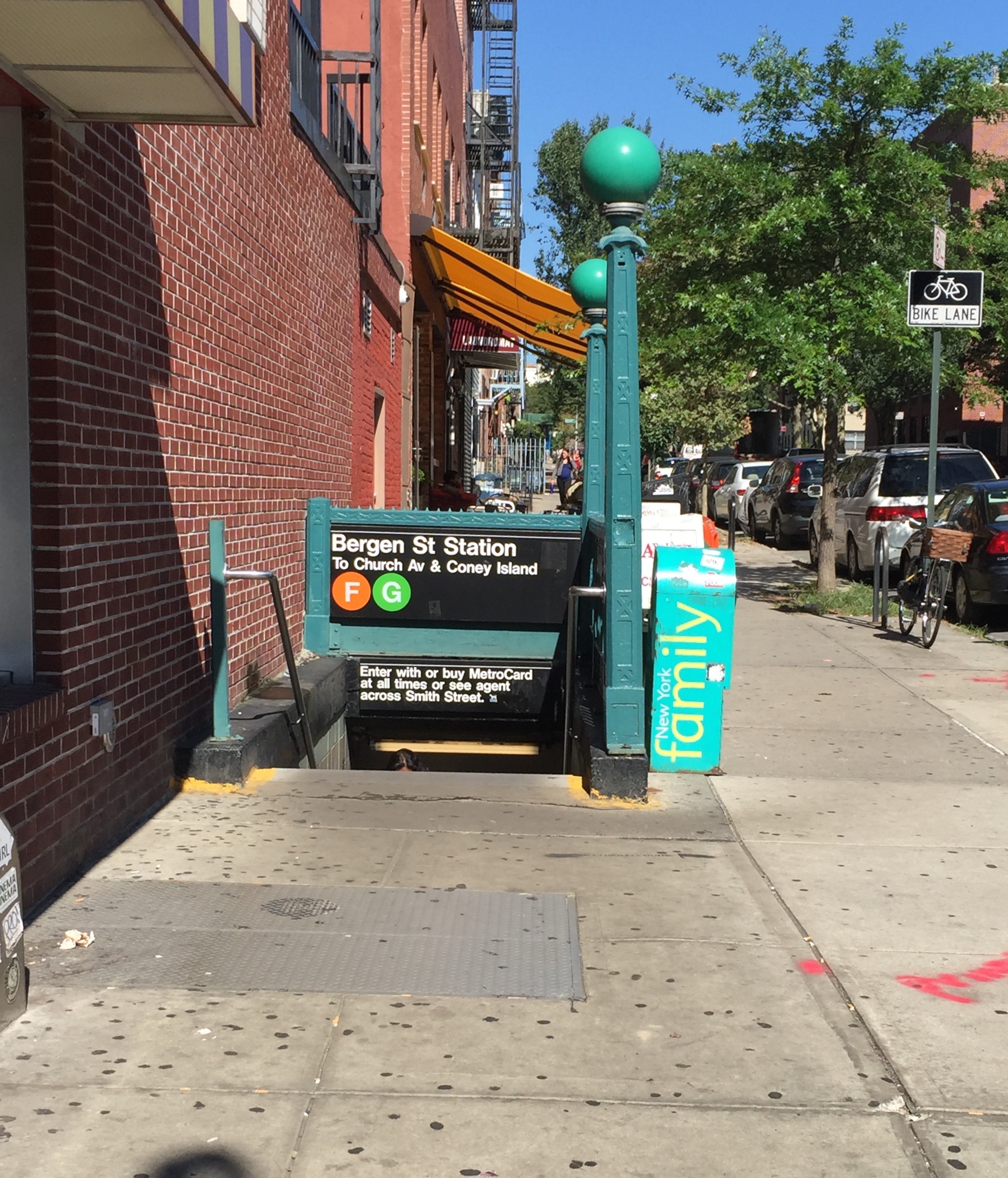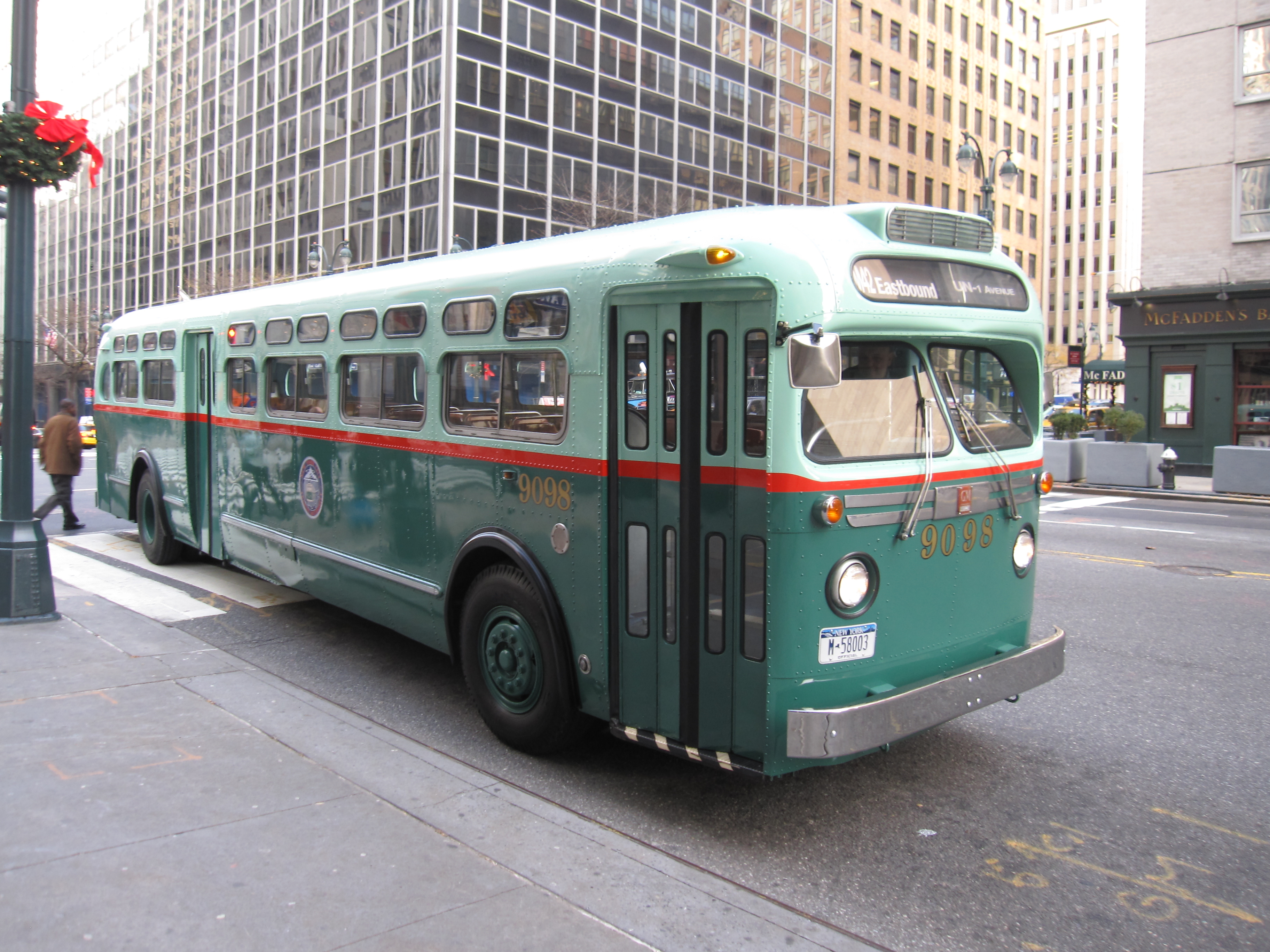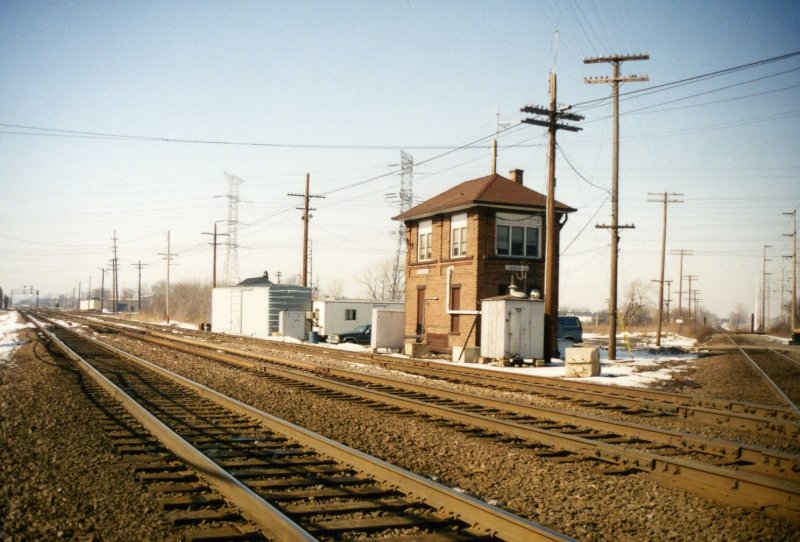|
Bergen Street (IND Culver Line)
The Bergen Street station is a station on the IND Culver Line of the New York City Subway, located at the intersection of Bergen Street and Smith Street on the border of Cobble Hill and Boerum Hill in Brooklyn. It is served by the F and G trains at all times. The Bergen Street station was constructed by the Independent Subway System (IND). It opened on March 20, 1933, as the original terminus of the Culver Line, which was known as the Smith Street Line or the South Brooklyn Line at the time. The station opened in advance of the opening of the remainder of the line to allow for it to compete with existing streetcar lines belonging to the Brooklyn–Manhattan Transit Corporation (BMT). Once the rest of the line was opened on October 7, 1933, the line was extended, making Bergen Street a station for through trains. Bergen Street was renovated in the 1990s. Bergen Street was constructed as a bi-level express station, though only the upper level is in use. The lower level is ... [...More Info...] [...Related Items...] OR: [Wikipedia] [Google] [Baidu] |
Brooklyn
Brooklyn () is a borough of New York City, coextensive with Kings County, in the U.S. state of New York (state), New York. Kings County is the most populous Administrative divisions of New York (state)#County, county in the State of New York, and the County statistics of the United States#Most densely populated, second-most densely populated county in the United States, behind New York County (Manhattan). Brooklyn is also New York City's most populous borough,2010 Gazetteer for New York State United States Census Bureau. Retrieved September 18, 2016. with 2,736,074 residents in 2020. Named after the Dutch village of Breukelen, Brooklyn is located on the western portion of Long Island and shares a border with the borough of Queens. It has several bridge an ... [...More Info...] [...Related Items...] OR: [Wikipedia] [Google] [Baidu] |
Jay Street–Borough Hall
A jay is a member of a number of species of medium-sized, usually colorful and noisy, passerine birds in the Crow family, Corvidae. The evolutionary relationships between the jays and the magpies are rather complex. For example, the Eurasian magpie seems more closely related to the Eurasian jay than to the East Asian blue and green magpies, whereas the blue jay is not closely related to either. Systematics and species Jays are not a monophyletic group. Anatomical and molecular evidence indicates they can be divided into an American and an Old World lineage (the latter including the ground jays and the piapiac), while the grey jays of the genus ''Perisoreus'' form a group of their own.http://www.nrm.se/download/18.4e32c81078a8d9249800021299/Corvidae%5B1%5D.pdf PDF fulltext The black magpies, formerly believed to be related to jays, are classified as treepies. Old World ("brown") jays Grey jays American jays In culture Slang The word ''jay'' has an ... [...More Info...] [...Related Items...] OR: [Wikipedia] [Google] [Baidu] |
Side Platform
A side platform (also known as a marginal platform or a single-face platform) is a railway platform, platform positioned to the side of one or more railway tracks or guideways at a railway station, tram stop, or bus rapid transit, transitway. A station having dual side platforms, one for each direction of travel, is the basic design used for double-track railway lines (as opposed to, for instance, the island platform where a single platform lies between the tracks). Side platforms may result in a wider overall footprint for the station compared with an island platform where a single width of platform can be shared by riders using either track. In some stations, the two side platforms are connected by a footbridge running above and over the tracks. While a pair of side platforms is often provided on a dual-track line, a single side platform is usually sufficient for a single-track line. Layout Where the station is close to a level crossing (grade crossing) the platforms may ei ... [...More Info...] [...Related Items...] OR: [Wikipedia] [Google] [Baidu] |
New York City Transit
The New York City Transit Authority (also known as NYCTA, the TA, or simply Transit, and branded as MTA New York City Transit) is a public-benefit corporation in the U.S. state of New York that operates public transportation in New York City. Part of the Metropolitan Transportation Authority, the busiest and largest transit system in North America, the NYCTA has a daily ridership of 8million trips (over 2.5billion annually). The NYCTA operates the following systems: *New York City Subway, a rapid transit system in Manhattan, the Bronx, Brooklyn, and Queens. *Staten Island Railway, a rapid transit line on Staten Island (operated by the subsidiary Staten Island Rapid Transit Operating Authority) *New York City Bus, an extensive bus network serving all five boroughs, managed by MTA Regional Bus Operations. Name As part of establishing a common corporate identity, the Metropolitan Transportation Authority in 1994 assigned popular names to each of its subsidiaries and affiliates. Th ... [...More Info...] [...Related Items...] OR: [Wikipedia] [Google] [Baidu] |
New York (magazine)
''New York'' is an American biweekly magazine concerned with life, culture, politics, and style generally, and with a particular emphasis on New York City. Founded by Milton Glaser and Clay Felker in 1968 as a competitor to ''The New Yorker'', it was brasher and less polite, and established itself as a cradle of New Journalism. Over time, it became more national in scope, publishing many noteworthy articles on American culture by writers such as Tom Wolfe, Jimmy Breslin, Nora Ephron, John Heilemann, Frank Rich, and Rebecca Traister. In its 21st-century incarnation under editor-in-chief Adam Moss, "The nation's best and most-imitated city magazine is often not about the city—at least not in the overcrowded, traffic-clogged, five-boroughs sense", wrote then-'' Washington Post'' media critic Howard Kurtz, as the magazine increasingly published political and cultural stories of national significance. Since its redesign and relaunch in 2004, the magazine has won more ... [...More Info...] [...Related Items...] OR: [Wikipedia] [Google] [Baidu] |
Interlocking
In railway signalling, an interlocking is an arrangement of signal apparatus that prevents conflicting movements through an arrangement of tracks such as junctions or crossings. The signalling appliances and tracks are sometimes collectively referred to as an ''interlocking plant''. An interlocking is designed so that it is impossible to display a signal to proceed unless the route to be used is proven safe. Interlocking is a safety measure designed to prevent signals and points/switches from being changed in an improper sequence. For example interlocking would prevent a signal from being changed to indicate a diverging route, unless the corresponding points/switches had been changed first. In North America, the official railroad definition of interlocking is: "''An arrangement of signals and signal appliances so interconnected that their movements must succeed each other in proper sequence''". Configuration and use A minimal interlocking consists of signals, but usuall ... [...More Info...] [...Related Items...] OR: [Wikipedia] [Google] [Baidu] |
Metropolitan Transportation Authority
The Metropolitan Transportation Authority (MTA) is a public benefit corporation responsible for public transportation in the New York City metropolitan area of the U.S. state of New York. The MTA is the largest public transit authority in the United States, serving 12 counties in Downstate New York, along with two counties in southwestern Connecticut under contract to the Connecticut Department of Transportation, carrying over 11 million passengers on an average weekday systemwide, and over 850,000 vehicles on its seven toll bridges and two tunnels per weekday. History Founding In February 1965, New York Governor Nelson Rockefeller suggested that the New York State Legislature create an authority to purchase, operate, and modernize the Long Island Rail Road (LIRR). The LIRR, then a subsidiary of the Pennsylvania Railroad (PRR), had been operating under bankruptcy protection since 1949. The proposed authority would also have the power to make contracts or arrangements w ... [...More Info...] [...Related Items...] OR: [Wikipedia] [Google] [Baidu] |
IND Crosstown Line
The IND Crosstown Line or Brooklyn–Queens Crosstown Line is a rapid transit line of the B Division (New York City Subway), B Division of the New York City Subway in Brooklyn and Queens, New York City, United States. It provides crosstown service between western Brooklyn and northwestern Queens and is the only subway line that does not carry trains to and from Manhattan. Extent and service The following services use part or all of the IND Crosstown Line, whose services' bullets are colored lime green: The only service to use the Crosstown Line is the . No revenue service has run over the line north of Court Square (IND Crosstown Line), Court Square since 2010. The north end of the Crosstown Line is a flying junction with the IND Queens Boulevard Line and 60th Street Tunnel Connection just south of Queens Plaza (IND Queens Boulevard Line), Queens Plaza. The line then travels south as a two-track line, except for a center relay track south of Court Square. At the turn from Marc ... [...More Info...] [...Related Items...] OR: [Wikipedia] [Google] [Baidu] |
Church Avenue (IND Culver Line)
The Church Avenue station is an express station on the IND Culver Line of the New York City Subway. Located at Church and McDonald Avenues in Kensington, Brooklyn, it is served by the F and G trains at all times (the latter of which terminates here), and by the <F> train during rush hours in the peak direction. The Church Avenue station was constructed by the Independent Subway System (IND). It opened on October 7, 1933, as the new terminal of the Culver Line, which was known as the Smith Street Line or the South Brooklyn Line at the time. In 1954, this station ceased to be the line's terminal with the completion of the Culver Ramp, which connected the South Brooklyn Line and the Brooklyn–Manhattan Transit Corporation (BMT)'s Culver Line and allowing service to run to Coney Island. Though the Church Avenue station contains four tracks and two island platforms, as with many express stations in the New York City Subway, the inner tracks see limited use, being used ... [...More Info...] [...Related Items...] OR: [Wikipedia] [Google] [Baidu] |
IND Eighth Avenue Line
The IND Eighth Avenue Line is a rapid transit line in New York City, United States, and is part of the B Division of the New York City Subway. Opened in 1932, it was the first line of the Independent Subway System (IND), and the ''Eighth Avenue Subway'' name was also applied by New Yorkers to the entire IND system. The line runs from 207th Street in Inwood south to an interlocking south of High Street in Brooklyn Heights, including large sections under St. Nicholas Avenue, Central Park West, and Eighth Avenue. The entire length is underground, though the 207th Street Yard, which branches off near the north end, is on the surface. Flying junctions are provided with the IND Concourse Line, IND Sixth Avenue Line, and IND Queens Boulevard Line. Most of the line has four tracks, with one local and one express track in each direction, except for the extreme north and south ends, where only the two express tracks continue. Internally, the line is chained as Line "A", wit ... [...More Info...] [...Related Items...] OR: [Wikipedia] [Google] [Baidu] |

.jpg)


.jpeg)

.jpg)
